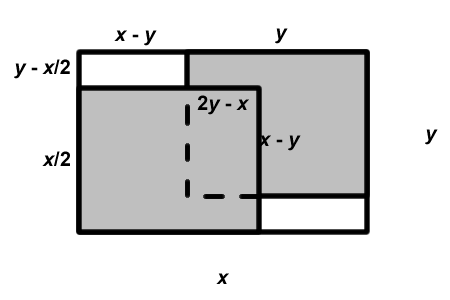Copyright © University of Cambridge. All rights reserved.
'Double Cover' printed from https://nrich.maths.org/
Show menu
We start by placing the two halves on the table so that the whole table is covered. Then we move them to overlap as in the question.
The area of the table covered by the paper has decreased by the two uncovered areas. The area covered by the paper has decreased by the amount covered twice. These two areas must both be the same, so the ratio must be $1:1$
Alternatively:

Let the sheet of paper have length $x$ and width $y$. Then the uncovered area consists of two congruent rectangles of length $x-y$ and width $y-\frac{1}{2}x$. So the uncovered area is $2(x-y)(y-\frac{1}{2}x)$, that is, $(x-y)(2y-x)$.
The area covered twice is a rectangle of length $y-(x-y)$, that is, $2y-x$, and width $\frac{1}{2}x-(y-\frac{1}{2}x)$, that is, $(x-y)$. So the area covered twice is also $(x-y)(2y-x)$.
This problem is taken from the UKMT Mathematical Challenges.
You can find more short problems, arranged by curriculum topic, in our short problems collection.